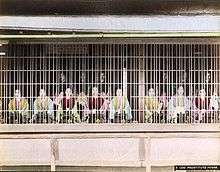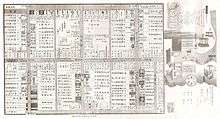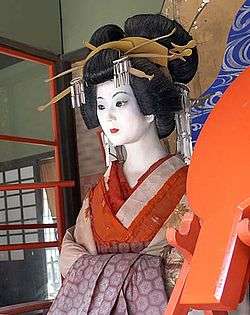Yoshiwara
- For the Yoshiwara nightclub in the 1927 Fritz Lang film see Metropolis.
- For the locality in Mumbai, see Oshiwara

Yoshiwara (吉原) was a famous yūkaku (遊廓、遊郭, pleasure district, red-light district) in Edo, present-day Tōkyō, Japan.
In the early 17th century, there was widespread male and female prostitution throughout the cities of Kyoto, Edo, and Osaka. To counter this, an order of Tokugawa Hidetada of the Tokugawa shogunate restricted prostitution to designated city districts. These districts were Shimabara for Kyōto (1640[1]), Shinmachi for Ōsaka (1624–1644[1]) and Yoshiwara for Edo (1617[1]). A leading motive for the establishment of these districts was the Tokugawa shogunate attempt to prevent the nouveau riche chōnin (townsmen) from engaging in political intrigue.[1]
History

The Yoshiwara was created in the city of Edo, near what is today known as Nihonbashi, near the start of the busy Tōkaidō that leads to western Kyoto in western Japan. In 1656, due to the need for space as the city grew, the government decided to relocate Yoshiwara and plans were made to move the district to its present location north of Asakusa on the outskirts of the city.
The old Yoshiwara district burned down (along with much of the city) in the Meireki fire of 1657; it was rebuilt in the new location, when it was renamed Shin Yoshiwara (New Yoshiwara), the old location being called Moto Yoshiwara (Original Yoshiwara); eventually the "Shin" was dropped, and the new district became known simply as the Yoshiwara.[2]
The Yoshiwara was home to some 1,750 women in the 18th century, with records of some 3,000 women from all over Japan at one time. The area had over 9,000 women in 1893, many of whom suffered from syphilis.[3] These girls were often indentured to the brothels by their parents between the ages of about seven to twelve. If she was lucky, she would become an apprentice to a high-ranking courtesan. When the girl was old enough and had completed her training, she would become a courtesan herself and work her way up the ranks. The young women often had a contract to the brothel for only about five to ten years, but massive debt sometimes kept them in the brothels their entire lives.
One way a woman could get out of Yoshiwara was for a rich man to buy her contract from the brothel and keep her as his personal wife or concubine. Another would be if she managed to be successful enough that she was able to buy her own freedom. This did not occur very often, though. Many women died of sexually transmitted diseases or from failed abortions before completing their contracts.[4] A significant number served out their contracts and married a client, went into other employments (including other forms of prostitution), or returned to their family homes. In these cases, the advanced payments their parents received could be used to fund her dowry. (There was no stigma against marrying a former prostitute.[5])
Social classes were not strictly divided in Yoshiwara. A commoner with enough money would be served as an equal to a samurai. Though samurai were discouraged from entering the Yoshiwara area, they often did so. The only requirement on them was that all their weapons had to be left at the town's entrance gate. Also by law, brothel patrons were only allowed to stay for a night and a day at a time. Like all official policies for Yoshiwara, this was rarely enforced.
Yoshiwara became a strong commercial area. The fashions in the town changed frequently, creating a great demand for merchants and artisans. Traditionally the prostitutes were supposed to wear only simple blue robes, but this was rarely enforced. The high-ranking ladies often dressed in the highest fashion of the time, with bright colorful silk kimonos and expensive and elaborate hair decorations. Fashion was so important in Yoshiwara that it frequently dictated the fashion trends for the rest of Japan.
Most prostitutes were however young girls from poor families and were completely exploited. Most of them were so poor, that when they died, their bodies were brought in anonymously to Jōkan-ji temple and left there at the back entrance since a proper burial would have been too expensive. The temple therefore also became known as Nage-komi dera (Throw-away temple). A memorial to thousands of anonymous prostitutes of the Yoshiwara was consecrated in the Meiji era.[6]
The area was damaged by an extensive fire in 1913, then nearly wiped out by an earthquake in 1923. It remained in business, however, until prostitution was outlawed by the Japanese government in 1958 after World War II.
Edo is now known as the city of Tokyo, Japan and prostitution is technically illegal, although this supposed illegality has been accomplished by applying a rather strained definition of the term (for example, the definition of "prostitution" does not extend to a "private agreement" reached between a woman and a man in a brothel). The area known as Yoshiwara, near Minowa station on the Hibiya Line, is now known as Senzoku Yon-chō-me and retains a large number of soaplands and other façades for sexual services.
People and services


People involved in mizu shōbai (水商売) ("the water trade"[7]) would include hōkan (comedians), kabuki (popular theatre of the time), dancers, dandies, rakes, tea-shop girls, Kanō (painters of the official school of painting), courtesans who resided in seirō (green houses) and geisha in their okiya houses.
The courtesans would consist of yūjo (women of pleasure/prostitutes), kamuro (young female students), shinzō (senior female students), hashi-jōro (lower-ranking courtesans), kōshi-jōro (high-ranking courtesans just below tayū), tayū (high-ranking courtesans), oiran, yarite (older chaperones for an oiran), and the yobidashi who replaced the tayū when they were priced out of the market.
In addition to courtesans, there were also geisha/geiko, maiko (apprentice geishas), otoko geisha (male geishas), danna (patrons of a geisha), and okaasan (geisha teahouse managers). The lines between geisha and courtesans were sharply drawn, however - a geisha was never to be sexually involved with a customer, though there were exceptions.[1]
Yoshiwara today
Today, Yoshiwara roughly corresponds to Tōkyō Taitō-ku Senzoku 4 Chōme (東京都台東区千束4丁目). At first glance, Yoshiwara today looks very similar to many other neighborhoods of modern Tokyo. Still, it does retain legacies to its past as it contains commercial establishments engaged in the sex trade, although police cracked down on the soaplands in 2007.[8] The street grid pattern and the temples and shrines from times past still exist.[9]
In popular culture
- The second act of Pietro Mascagni's opera Iris (1898) is set in the Yoshiwara.
- Yoshiwara is the name of the futuristic red-light district in the classic silent German film Metropolis (1927).
- The 1937 French film Yoshiwara, directed by Max Ophüls, is set in the Yoshiwara in the mid-19th century.
- The 1956 Japanese film Street of Shame, directed by Kenji Mizoguchi, is set in the Yoshiwara in the mid-20th century.
- Yoshiwara regularly appears in the anime Gintama.
See also
Notes
- 1 2 3 4 5 Avery, Anne Louise. Flowers of the Floating World: Geisha and Courtesans in Japanese Prints and Photographs, 1772–1926 [Exhibition Catalogue] (Sanders of Oxford & Mayfield Press: Oxford, 2006)
- ↑ Cecilia Segawa Seigle, Amy Reigle Newland, et al., A Courtesan's Day: Hour by Hour (Hotei, Amsterdam, 2004), pp. 9–11.
- ↑ De Becker, J. E. The Nightless City, or The History of the Yoshiwara Yūkaku, (Charles E. Tuttle, Tokyo, 1971), p. 360.
- ↑ Sone Hiromi. “Prostitution and Public Authority in Early Modern Japan,” in Women and Class in Japanese History, edited by Hitomi Tonomura, Anne Walthall, and Haruko Wakita. 169-85. Ann Arbor: Center for Japanese Studies the University of Michigan, 1999.
- ↑ Embree, John F. Suye Mura: a Japanese Village, Ann Arbor: Center for Japanese Studies University of Michigan, 1995.
- ↑ http://mmdc.net/blog/2008/10/28/the-throw-away-temple/
- ↑ Dalby, Liza. Geisha (London: Vintage, 2000)
- ↑ Screiber, Mark, "A soapland cleanup that could make a mess", Japan Times, 22 July 2011, p. 17.
- ↑ Waley, P. pp. 201–211.
References
- Waley, P. Tokyo Now & Then. First Edition (1984). John Weatherhill, Inc. ISBN 0-8348-0195-7.
External links

- Information about the Yoshiwara District
- Pictures and Information
- Image of Yoshiwara
- The Glittering World of the Japanese Courtesan?
- What was the Yoshiwara District? by Honolulu Museum of Art
- The Social Structure of the Yoshiwara Before 1750 by Honolulu Museum of Art
- The Social Structure of the Yoshiwara After the 1760s by Honolulu Museum of Art
- The Gentrification of the Yoshiwara by Honolulu Museum of Art
Coordinates: 35°43′26.36″N 139°47′44.49″E / 35.7239889°N 139.7956917°E